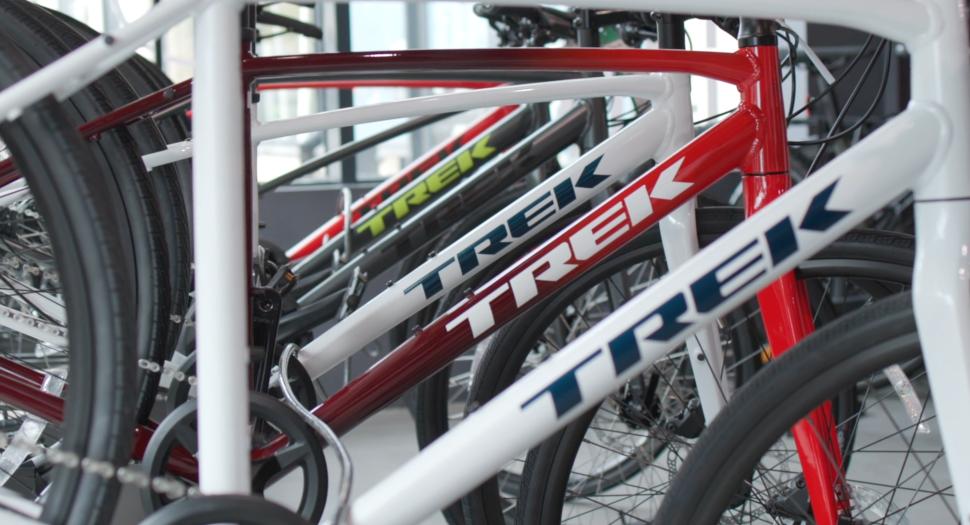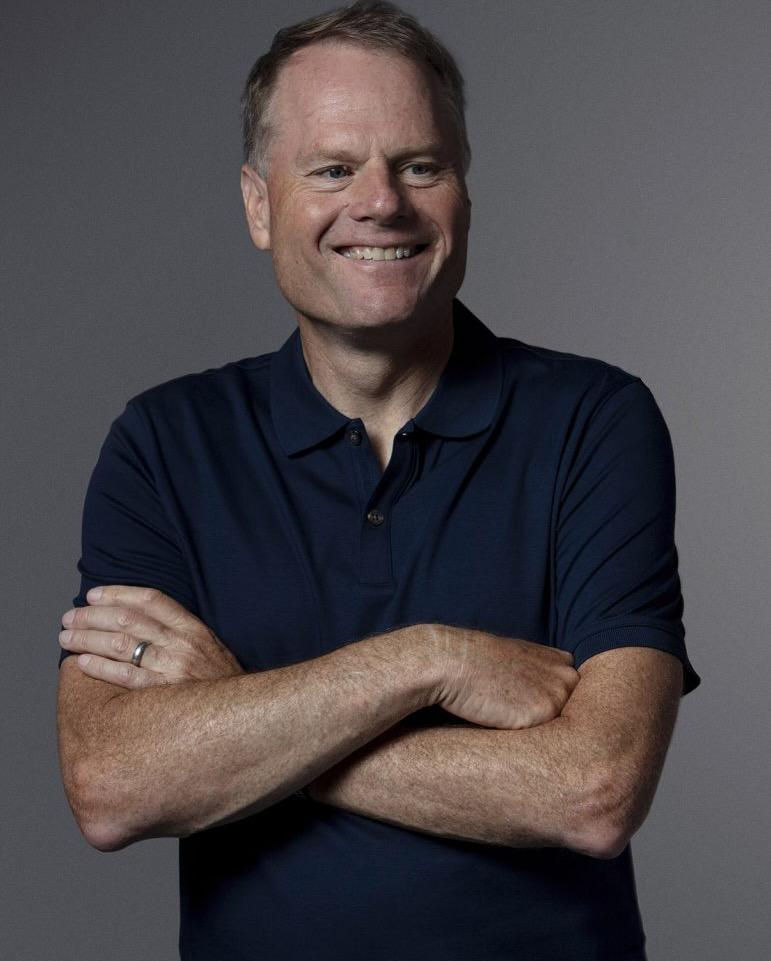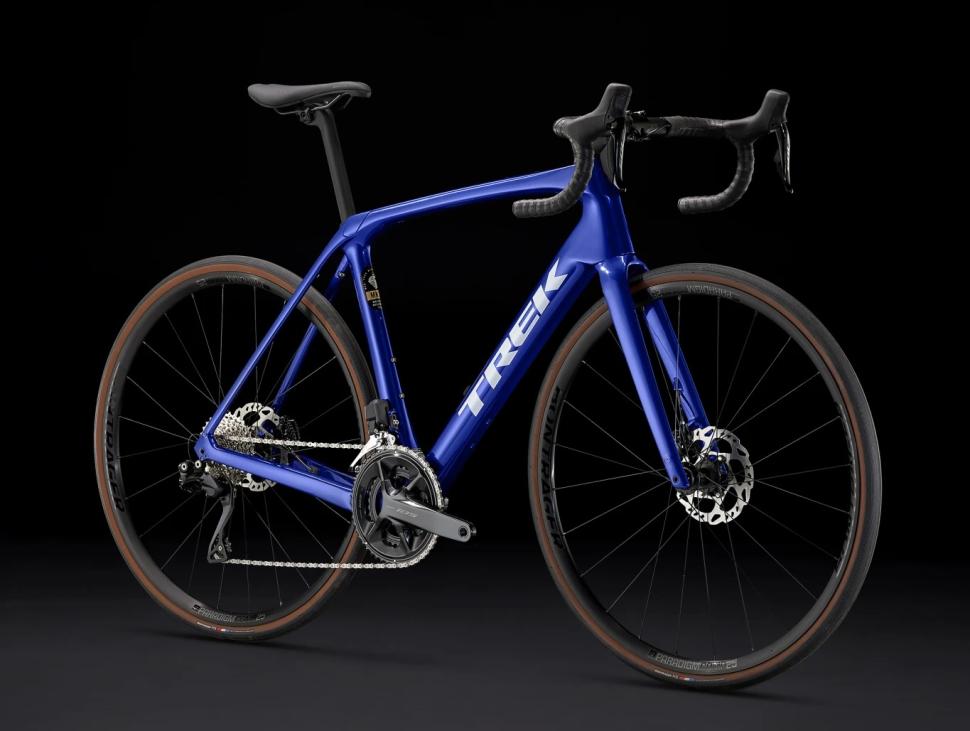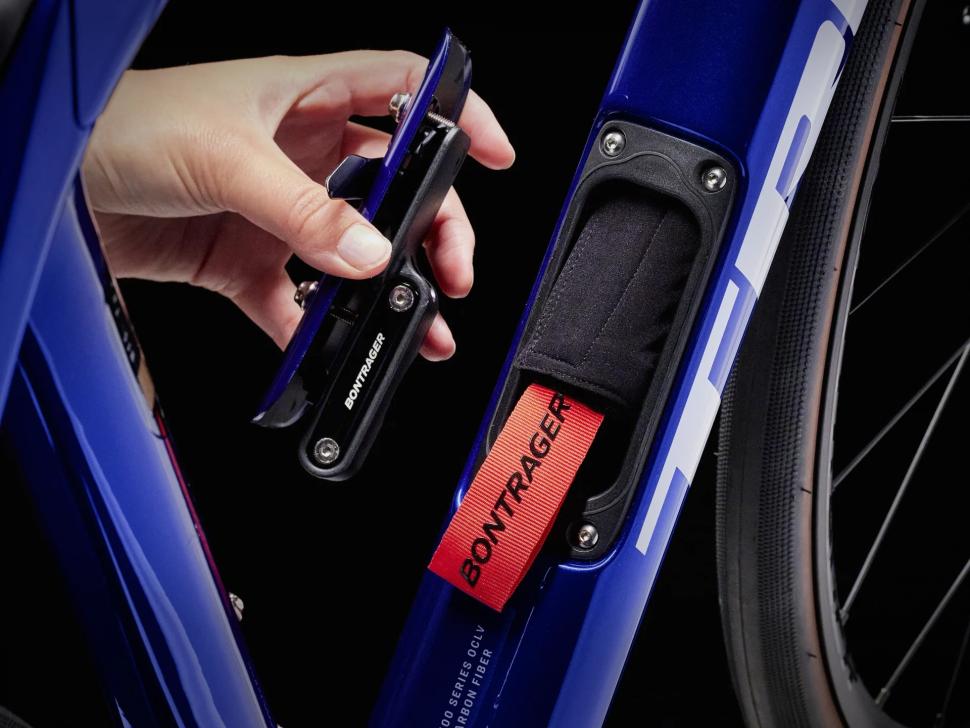- News
- Reviews
- Bikes
- Accessories
- Accessories - misc
- Computer mounts
- Bags
- Bar ends
- Bike bags & cases
- Bottle cages
- Bottles
- Cameras
- Car racks
- Child seats
- Computers
- Glasses
- GPS units
- Helmets
- Lights - front
- Lights - rear
- Lights - sets
- Locks
- Mirrors
- Mudguards
- Racks
- Pumps & CO2 inflators
- Puncture kits
- Reflectives
- Smart watches
- Stands and racks
- Trailers
- Clothing
- Components
- Bar tape & grips
- Bottom brackets
- Brake & gear cables
- Brake & STI levers
- Brake pads & spares
- Brakes
- Cassettes & freewheels
- Chains
- Chainsets & chainrings
- Derailleurs - front
- Derailleurs - rear
- Forks
- Gear levers & shifters
- Groupsets
- Handlebars & extensions
- Headsets
- Hubs
- Inner tubes
- Pedals
- Quick releases & skewers
- Saddles
- Seatposts
- Stems
- Wheels
- Tyres
- Health, fitness and nutrition
- Tools and workshop
- Miscellaneous
- Tubeless valves
- Buyers Guides
- Features
- Forum
- Recommends
- Podcast
TECH NEWS
 2023 Trek FX range
2023 Trek FX rangeThe bike industry is "in chaos" says boss: so what do Trek’s plans to ‘right size’ mean for the industry… and you?
In the latest development in the bike industry’s stormy commercial conditions, Trek Bicycle says that it plans to “right size” by cutting spending by 10% and reducing the number of individual products it offers by 40% over the next two years. This was originally reported by Bicycle Retailer and Industry News.
For those not fluent in corporate jargon, rightsizing is “the process of restructuring a business to meet new objections and increase efficiencies”, according to Forbes. In other words, Trek is changing things up to save money, although it says its overall strategy remains unchanged.
How do we know this? Although Trek has yet to announce anything officially, Bicycle Retailer and Industry News has got hold of an internal memo sent by company president John Burke to executives. Yeah, crafty. He said that these changes are a response to slow sales and high levels of inventory – the downturn in the bike industry’s fortunes, essentially.
John Burke said Trek would reduce overall spending by 10% with cuts to programmes and positions, with decisions on this made on or before last Friday (8th March). As mentioned, those decisions have yet to be made public.
Trek’s stock-keeping units (SKUs) in the 2026 model year will be 40% lower than in the 2024 model year. An SKU is a separate product that a company offers. If a particular product is available in several sizes and/or different colours, that all adds to the number of SKUs offered.
Does this mean Trek’s 2026 bike range will be 40% smaller in two years? Possibly, but bear in mind that Trek has a huuuuuuge range. As well as the road and mountain bikes you’re probably most familiar with, it also sells loads of city bikes, electric bikes, children’s bikes, cruisers, you name it. Trek sells a helluva lot besides bikes too – everything from stabilisers and kickstands to T-shirts and toe-covers – so let’s not get too alarmist. We’re unlikely to see the demise of the Madone, Emonda or Domane anytime soon.
John Burke is quoted as saying, “These are turbulent times in our business”, and he went on to say that the global bike market is “in chaos” with high stock levels at wholesale and retail levels, leading to “significant and continued” discounting.
Judging by pretty much everything that we’ve been hearing since the end of the Covid-induced bike boom, that’s a fair comment. You only have to take a look online and you’ll see huge discounts right, left, and centre as companies try to shift stock that’s cluttering up warehouses and shops to make way for the new stuff that’s on order.
In the UK, the apparent impending demise of Wiggle Chain Reaction Cycles – at least in its current form – is only exacerbating the situation. How does anyone compete with a massive powerhouse that’s having a final clearance sale and selling off bikes at 30-50% off?
John Burke said that retail sales were below the levels forecast by Trek and that the company had not hit its monthly sales goals for the past 15 months. Rather than simply hoping for better days ahead or continuing to make cuts around the edges, he said Trek had to “right-size our business to the realities of the marketplace”.
In Trek’s case, reducing the number of products it’ll be offering also chimes with the company’s drive towards sustainability. Trek outlined its intention to launch a trade-in and refurbishment scheme last year, initially confined to the United States of America, to cut down on waste and extend the lifespan of its bicycles, even if that means making and selling less. That said, whether Trek’s plans to rightsize result in producing less overall or simply offering fewer options remains to be seen.
What are the implications of Trek’s decisions? We’ve spoken to several industry insiders who, off the record, say that we could be about to see many other major companies rationalise their activities to increase efficiency.
During the pandemic, we saw a huge shortage of bikes and equipment. It’s only three years since we ran a story on road.cc: Britain’s bike shortage, part 1: what’s going on, when will supplies return, and how can you improve your chances of bagging the bike you want?
Wow! Back then, bike brands could sell pretty much whatever they could produce, and they were falling over themselves to add new production lines and even build entirely new factories. How times change.
Specialized slashes jobs in latest sign of cycling industry downturn
Are we likely to see similar moves from other big companies? Yes, even though most will probably manage to enact their right-sizing strategies more privately, without leaks to the media.
Bicycle Retailer and Industry News quotes Steve Fenton, owner of Pro-Lite Manufacturing, as saying, “I might be going totally against the grain with what I'm going to tell you, but I think it's the right thing to do, and actually if I was in charge, I'd be doing it on a much bigger scale. My opinion is that all (the big brands) have to do it.”
Is right-sizing likely to affect some areas of the bike market more than others? It’s possible, yes. Most mountain bikes tend to be more complex than most road bikes due to their suspension systems; there are more parts involved. The same goes for electric bikes. Our industry contacts say that these sectors are likely to be hit by rightsizing more than road bikes where the options on offer can be potentially reduced far less. That’s a bit of a simplification, though. Different companies are likely to be affected in different ways depending on their own particular exposure to overstocks in certain areas.
Naturally, we have contacted Trek for comment, but got a big “no comment” from those guys. Maybe they’ll release a full statement at some stage. We did, though take the opportunity to ask Ian Whittingham, Co-Founder/ Director of Sigma Sports, for his take on the situation.
“I think a lot of this makes sense,” he said. “I think it’s a good time to reset and have a look at what you're offering, to consider whether you really need that many colour options or model options within each range. It’s probably quite a sensible move by Trek for their size business. It’s certainly something we've done in the last couple of years post-COVID. “We’ve been trying to curate our ranges a bit better than we might have done before to make sure we were in stock with the right stuff rather than big, broad ranges of products.”
Latest Comments
- rogerwb 1 hour 53 sec ago
Generalisations are valid in this case; there are enough boomers with negative attitudes to young people to be able to block good things like this....
- mattw 5 hours 59 min ago
This risks turning me into a hanger and flogger....
- wtjs 9 hours 59 min ago
In SE London, psychopath riders are the majority of people on bicycles Oh dear! another festive stealth anti-cyclist ☃️
- wtjs 10 hours 4 min ago
Well, you know the BMW drivers' saying: knock that house (hospital, social housing, care home, hospital...) down, could save 30 seconds on the trip!
- Spangly Shiny 11 hours 39 min ago
I had the pleasure of owning two of the featured builders here, in my history. When I joined the Army in 1971, I took with me my curly Hetchins:...
- Username 12 hours 44 min ago
Could Siobhán paint it red and noone would notice it?
- Spangly Shiny 1 day 3 hours ago
To paraphrase Field of Dreams, "Build it right and they will come: and use it!"
- Rendel Harris 1 day 5 hours ago
And a Happy Christmas to you, road.cc staff!
- Rendel Harris 1 day 6 hours ago
The odds of not being able to find a single pedestrian - just one, note, "any pedestrian" - in an area containing more than about ten of them who...



Add new comment
24 comments
Funily enough it will be all about making bigger profits. If they were serious about sustainability they would manfacture as close as possible to local markets. They won't and people will defend them for it.
I'm not sure that works. Multiple framebuilding and assembly factories on each continent, parts shipped to each one then distributed 'locally' in a radial or similar fashion is not cheaper or as efficient otherwise many brands would have done that already. It's similar to why local bakeries, skilled trades and craftspeople have been put out of work - it's cheaper to buy shitty Chorleywood 'bread' and thousands of other items (including many non-food products) from a supermarket instead of a local shop.
Centralising manufacture and assembly to one centre of excellence (in this case mainly Taiwan, which isn't too far from where many components are manufactured) and sent around the world in containers seems more sensible to me.
And it's not necessarily about bigger profits but remaining profitable in a shrinking market instead of carrying on as before then going into administration, as has happened to any number of brands, distributors and retailers.
They certainly want the profit they were making. But they really are trying to stop the bleeding right now. They don't want bike shops closing which is what's happening
Do you think it would be more sustainable to have component and frameset factories build in every region of the world, for every bike company?
Trek is an equivalent of a slow, wobbly oil tanker with too much weigth on the very top, too many captains on the bridge, too far from the rest of the crew.
I believe it is high time for big companies to try cheaper components. There are groupset companies that are practically unknown yet they are way cheaper and with better reviews. Make your base model as cheap yet good as possible but also open to upgrades (hate to see 7 speed base models from big brands) and money will follow.
Ah, but what price do the big companies actually pay? I'll bet it's not the full rrp that even single clients don't cough up, but much, much less.
Sure the OEM prices they pay are much cheaper, but given that a bike cost now as a groupset, every cost saving is welcome especially at lower spec bikes. At higher end models, I am sure that there are people happy to pay crazy prices for bikes.
I know how much cheaper they are for OEMs. But that largely just offsets the bike building costs, at least for lower tear bikes.
Those cheapo components from Empire and LTwoo are cheap because they're only making a bit of profit over their costs. They're not going to slash that profit for Trek, Specialized and Giant to get reasonable wholesale prices they can profit on.
So Trek is finally having to address their haphazard way of doing business where they added way too many products and options in search of increasing top line revenue, while jacking up prices on everything (as most of the bike industry has been doing) in order to increase profits despite the poor planning and execution. Corporate greed is a constant, it's just a matter of which was the executives are currently attempting to implement it.
Now they'll cut product options and staff to ensure they can continue to reap the same rewards from the lower revenues since the Covid bike boom is long over and a lot of cyclists aren't willing to deal with bikes, even with some of the current steep discounts still being more expensive (even inflation adjusted) than their equivalent 10 years ago. The eye watering price of middle to top tier bikes that aren't much different than those bikes, except some aero improvements that have a negligible impact to 99% of the buyers since we don't ride at pro level speeds needing those questionable 10 seconds over 40k at 45kph....
It doesn't hurt that the market is insatiable when people have money to spend. They just reacted to that, we didn't have to buy but they reacted to that money they were being flooded with. The reality is that they were very short-sighted. No different than Americans buying big trucks when gas is cheap(gas is always cheap in the US😂) and hybrids when gas is "expensive" like those prices aren't just going to fluctuate again and again
Trek has gone way overboard with how many different models they sell, they have at least 60 different bikes, and that doesn't include children's bikes.
Heck, personally I think all they really need is 5 within each category, they have 4 categories and 1 child category, which would leave about 25 bike models.
Chop at least half of those would save Trek a lot of money, and prevent as much confusion among buyers as to what to get.
I think the big thing they need to do is get rid of the 3 different carbon layups they offer for many bikes. Specialized did this with the Tarmac. 2 is plenty. And while I wouldn't be a fan, not offering as many colors in every model will save tons of money.
Like a lot of companies, they've got far too many performance models; are they really all needed? Similarly, I had a look at their alloy MTB Hardtails; Marlin, Roscoe, X-Caliber, Procaliber......Are all those really needed?
You've listed entry and performance models for both trail and XC race hard tails. I doubt there is much market for a cheap line of dedicated race bikes, when that product space is covered by the lower spec options of the Procaliber.
The proliferation of SKUs in the MTB sector have also been compounded by the COVID boom coinciding with the rise in popularity for 29" FS bikes, which has blurred the lines further between use case product categories. Where there used to be XC, trail/AM, Enduro and DH, XC still sits in the 100-120mm travel range, but now there's also Down-country, Enduro has grown and split into short travel enduro and super-enduro.
Who even knows what to class a 140mm travel bike as now?
If they're serious about cutting SKUs and sustainability then they should move away from the annual refresh cycle, it's madness. Shimano don't release a new group each year. We don't need 8 new versions of the Giant Defy when they're still busy selling '22 inventory. Only replace a model when there's a fundamental shift (e.g new geo to accommodate wider tubeless tyres)
This!
Component brands don't do it, car brands don't do it, motorcycle brands don't do it, and bicycle brands shouldn't do it either.
Nobody should care if a bike is 'last year's model' as long as its tech (or look) is not too outdated.
But it's generally only the paint scheme that changes from year to year. The frame stays unchanged for maybe 4-5 years. The automotive industry does similar, with cosmetic changes (light clusters, bumpers and grill) changing while the metal underneath stays the same.
Have you ever looked at cars from year to year?😂
Yes. They don't change from year to year.
They do exactly what every car and electronics company does(not phones) and have been doing this for decades. The issue really hurting the industry is really still online shopping...a problem throughout all retail industries
So, get your aero 650b gravel commuting bike now, before ultra-niche product catagories are rationalised out of existance.
It's more likely that they will cut the number of options for each bike - groupset/spec level, colours, maybe even sizes. And as the article states, a lot of the SKUs will be for parts and accessories.
Trek GB's website shows 12 road helmets (with up to 5 colour options for each); 12 MTB helmets (ditto, 42 options); 29 commute/fitness helmets and 7 kids' helmets. Almost all of them will be available in multiple sizes. SKUs a-plenty!
When you consider that the helmet market has many established brands then does it really make sense for Trek to stock and promote up to 200 helmet models of their own?
The Equipment category encompasses everything from handlebars, pumps and panniers to phone & tablet accessories. There are 17 models in Shoes. The £150 Circuit road shoe is available in 13 sizes and 5 colours, that's potentially 65 options for a single model. That category also lists overshoes, 3 footbeds/insoles in 5 sizes and parts including Bontrager branded SPD and 3-bolt Look-compatible cleats. They sell 8 models of bottle cage, one of which has 12 colour options.
The handlebar category lists 95 items, quite a few of which are Speed Concept aerobars & very specific parts. This is a shrinking market, even triathlon is seeing a significant drop in participation and there are very few people interested in the blinged-up, barely used TT/tri bikes I see advertised online.
I don't consider this to be either wise or sustainable. It would be too simplistic to say "Trek should just focus on selling bikes" but there are surely good (and it seems now pressing) reasons to reduce inventory and the overheads associated with the 'everything with our name on it' path they have gone down.